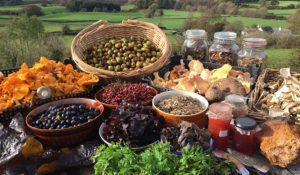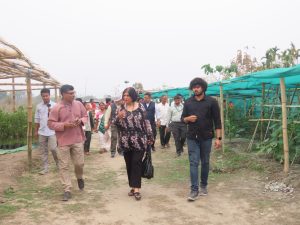Introduction: The Call for Sustainable Agriculture
Agriculture has long been the backbone of India’s economy, and the conservation of native crop varieties is crucial for ensuring food security, environmental sustainability, and climate resilience. Recognizing this, Dr. Vibha Dhawan, Director General of The Energy and Resources Institute (TERI), recently highlighted the need for preserving high-yielding indigenous crop varieties during a stakeholder consultation program in Udalguri, Assam.
The event, organized by Aaranyak under the GEF-UNDP Small Grants Programme, brought together experts, farmers, and environmentalists to discuss sustainable agricultural practices, biodiversity conservation, and human-elephant coexistence. Dr. Dhawan underscored the need to integrate traditional farming knowledge with modern scientific approaches to enhance productivity while maintaining ecological balance.
Importance of Native Crop Varieties
Native crop varieties, often referred to as landraces, have evolved over centuries, adapting to local environmental conditions. These varieties possess unique traits such as drought resistance, pest tolerance, and higher nutritional content, making them indispensable for climate-resilient agriculture. However, the widespread adoption of hybrid and genetically modified crops has led to a decline in indigenous varieties, putting agricultural biodiversity at risk.
Dr. Dhawan emphasized that conserving these native crops can help farmers achieve higher yields without excessive dependence on chemical fertilizers and pesticides. She also pointed out that these crops have a natural resilience to extreme weather conditions, making them a reliable choice for farmers in regions prone to climate fluctuations.

The Role of Aaranyak and the GEF-UNDP Small Grants Programme
Aaranyak, a leading biodiversity conservation organization, has been actively working to promote sustainable agricultural practices and environmental conservation. Under the GEF-UNDP Small Grants Programme, the organization aims to support local farmers by encouraging the cultivation of native crop varieties, improving soil health, and fostering human-elephant coexistence.
The program focuses on capacity building, providing farmers with the necessary knowledge and resources to transition towards sustainable farming. This includes training sessions on organic farming, soil management, and water conservation techniques. By adopting these methods, farmers can reduce their reliance on synthetic inputs and improve the long-term fertility of their land.
Soil Health and Sustainable Farming Practices
One of the key concerns raised during the consultation program was soil degradation caused by the excessive use of chemical fertilizers and pesticides. Dr. Dhawan stressed the importance of restoring soil health through organic farming practices, such as crop rotation, composting, and the use of biofertilizers.
Healthy soil is the foundation of productive agriculture, as it enhances water retention, supports beneficial microorganisms, and provides essential nutrients to crops. By adopting regenerative agricultural practices, farmers can improve soil structure and fertility, leading to sustainable long-term yields.


Challenges in Preserving Native Crops
Despite their numerous advantages, native crop varieties face several challenges, including:
- Lack of Awareness: Many farmers are unaware of the benefits of indigenous crops and continue to rely on commercial hybrid seeds.
- Market Demand: The dominance of hybrid and genetically modified crops in the market has reduced the demand for native varieties.
- Limited Availability of Seeds: The conservation and distribution of native seeds require organized efforts, including the establishment of seed banks and farmer cooperatives.
- Policy and Institutional Support: While there are government initiatives to promote organic farming, more focused policies are needed to incentivize the cultivation of native crops.
Dr. Dhawan highlighted that addressing these challenges requires collaboration between government agencies, research institutions, NGOs, and the farming community. Encouraging farmer-led seed conservation initiatives and creating market linkages for indigenous crops can help revitalize their cultivation.
7 Powerful Ways to Preserve Native Crop Varieties
1. Community Seed Banks: Establishing local seed banks to store and distribute native seeds ensures their availability and prevents genetic erosion.
2. Organic and Regenerative Farming: Encouraging chemical-free farming practices enhances soil health and supports the growth of indigenous crops.
3. Farmer-Led Conservation Initiatives: Training and incentivizing farmers to cultivate and exchange native seeds helps maintain biodiversity.
4. Agroecological Research and Innovation: Investing in scientific research to enhance the yield and resilience of native crops through eco-friendly methods.
5. Market Integration and Branding: Creating niche markets and certifications for native crops boosts demand and economic viability for farmers.
6. Government Policies and Incentives: Advocating for financial support, subsidies, and policies that promote the cultivation of indigenous varieties.
7. Public Awareness and Education: Conducting campaigns to educate consumers and farmers on the benefits of native crops and sustainable agriculture.
The Significance of Human-Elephant Coexistence
Another crucial aspect discussed during the program was the issue of human-elephant conflict, a significant challenge in Assam’s agricultural landscape. Rapid deforestation and habitat destruction have forced elephants to venture into farmlands, leading to crop damage and economic losses for farmers.
Aaranyak’s initiatives under the GEF-UNDP Small Grants Programme focus on promoting sustainable agricultural practices that minimize human-wildlife conflicts. Strategies such as creating buffer zones, using non-lethal deterrents, and establishing alternative livelihood options for affected communities are being explored to foster harmonious coexistence.
Government Initiatives and Policy Support
The Indian government has launched various programs to support sustainable agriculture and biodiversity conservation. The Paramparagat Krishi Vikas Yojana (PKVY) encourages organic farming, while the National Bureau of Plant Genetic Resources (NBPGR) works on conserving plant genetic diversity.
However, Dr. Dhawan stressed the need for more localized policy interventions to protect native crop varieties. She called for increased funding for seed banks, farmer training programs, and research on indigenous crops. By integrating traditional farming practices with modern agroecological approaches, policymakers can create a more resilient agricultural system.

Impact on Local Farmers and Communities
The efforts to preserve native crop varieties and implement sustainable farming practices have far-reaching benefits for local farmers. By adopting indigenous crops, farmers can lower input costs, increase resilience to climate change, and secure stable incomes. Moreover, the promotion of organic farming practices enhances food quality and safety, benefiting consumers as well.
Aaranyak’s engagement with farming communities through workshops and field training has empowered many farmers to embrace sustainable agriculture. Testimonials from local farmers indicate that transitioning to native crops and organic farming has not only improved their yields but also strengthened their connection with traditional agricultural practices.
Future Roadmap for Sustainable Agriculture
Looking ahead, continued efforts are needed to scale up the conservation of native crop varieties and promote sustainable agriculture. Key steps include:
1. Strengthening Seed Banks and Farmer Networks: Establishing community-led seed banks to ensure the availability of native seeds.
2. Enhancing Research and Development: Encouraging scientific studies on the nutritional and economic benefits of indigenous crops.
3. Policy Advocacy and Financial Support: Urging policymakers to introduce subsidies and incentives for farmers cultivating native crops.
4. Public Awareness Campaigns: Educating farmers and consumers about the advantages of native crop varieties through media and outreach programs.
5. Expanding Market Opportunities: Creating supply chains and market linkages to boost the demand for native agricultural produce.
Conclusion: A Call to Action
The stakeholder consultation in Udalguri served as a crucial platform for discussing sustainable agricultural practices and the preservation of native crop varieties. Dr. Vibha Dhawan’s insights reinforced the importance of integrating traditional wisdom with scientific advancements to achieve food security and environmental sustainability.
Moving forward, it is essential for farmers, researchers, policymakers, and conservationists to collaborate in preserving indigenous crop varieties and promoting sustainable farming. By doing so, India can build a resilient agricultural system that supports both farmers’ livelihoods and ecological balance.

Read More: Sustainable agriculture and the preservation of native crops are crucial for rural development, just as grassroots sports initiatives are transforming lives. Read more about how Nagaland is fostering football talent: Nagaland’s Football Initiatives.

